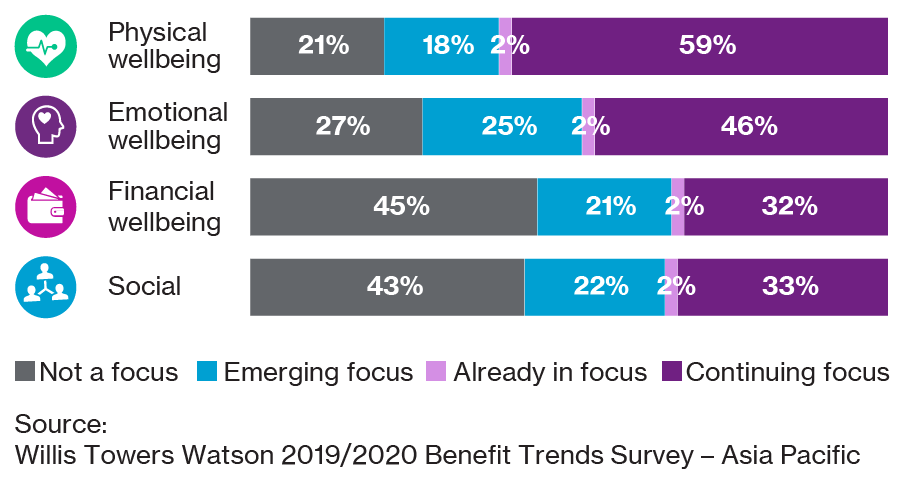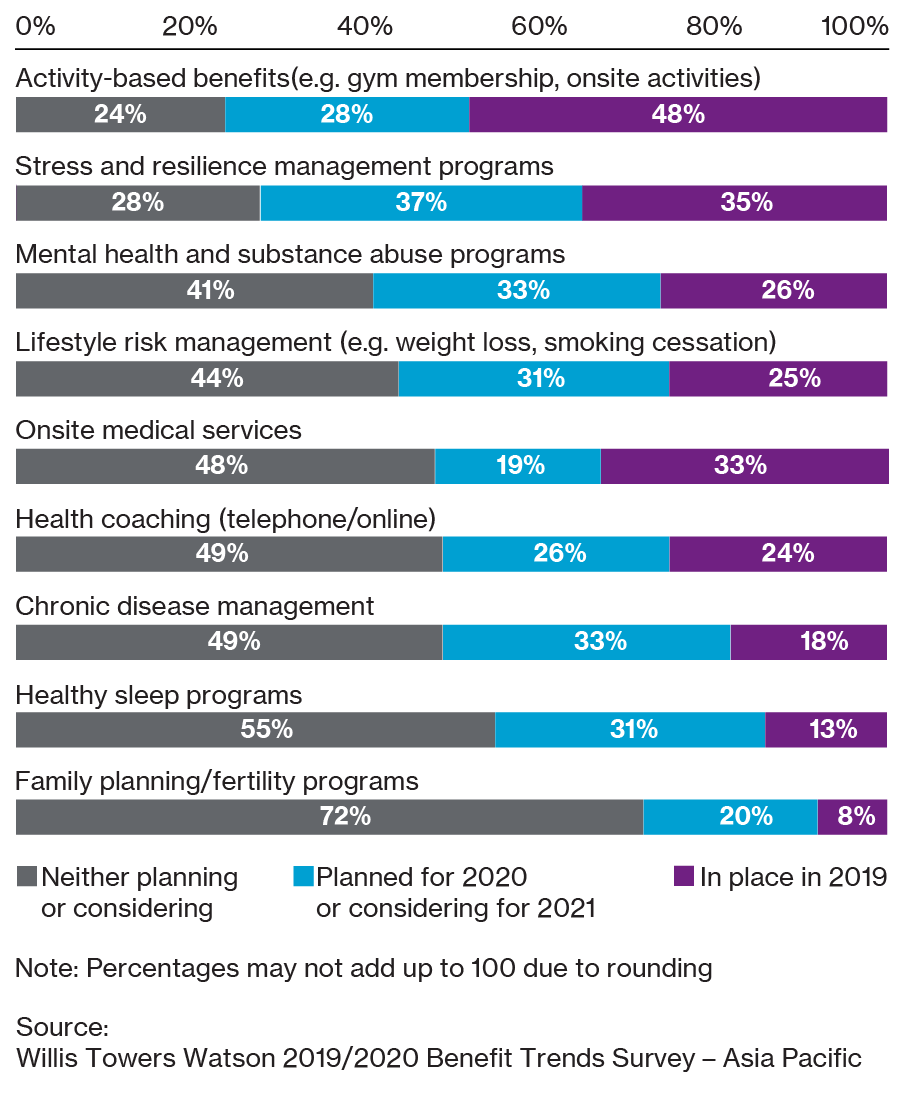Wellbeing is gaining prominence as a strategic priority in Asia Pacific, with 60% of organisations expanding their focus on wellbeing initiatives in the near future. 1 This shift can be attributed to a number of drivers, from escalating health costs to the need to provide a multi-generational workforce with a suite of benefits that appeals to them. As the talent war continues to rage in Asia Pacific, many employers also feel that a thoughtful approach to wellbeing gives them an edge over other employers, particularly when it comes to younger employees entering the workforce. Employers need to remain conscious of the changes while preparing themselves to embrace the future of work with open arms.
60% of organisations are expanding their focus on wellbeing initiatives in the near future.
As the prominence of wellbeing grows, the corporate understanding of it has also broadened. This is not the corporate wellbeing of the past, with healthy eating options in cafeterias, and onsite gyms. Employers today understand that wellbeing is about so much more than just physical fitness and health.
We are seeing leading organisations today taking a holistic and integrated view of wellbeing – from physical aspects, to emotional, social and also financial (Figure 1).
Identifying and effectively managing population health risks and chronic conditions across the workforce
Identifying and implementing solutions to improve the financial health of your workforce
Identifying and managing behavioural health, stress and substance use issues across the workforce
Identifying and implementing ways to promote a sense of involvement around health and financial issues between employees, families and the community
The level to which each of these aspects will apply to any given workforce is in many ways linked to the makeup of that workforce – different age groups, gender mix, employees’ life stage, the type of work they do, where they are located, and so on. For instance, a younger employee may be more concerned about emotional and social health, while an older worker who has just started a family or is near retirement is more likely to have financial anxieties and look for support on their financial wellbeing.
The importance of emotional health will resonate particularly for many employees and is therefore something employers will want to consider.
With stress being an ever-present challenge – and more so today with concerns around economic and political uncertainties, and the stability of jobs in the future of work – the importance of emotional health will resonate particularly for many employees and is therefore something employers will want to consider.
The prevalence of mental health issues continues to grow and one of the key drivers is the culture of long working hours seen across Asia Pacific. According to a new study by a Hong Kong-based trade union, one in five employees are on the job an average of 55 hours a week, which is equivalent to 20% of the city’s three million employees working longer than the 40-hour standard. 2
Another study further added Singapore and Malaysia to the list of countries that recorded longer working hours, with an average of 12 hours over their contracted hours. Indonesia has 14.3% of its workforce doing work for more than 60 hours in a week and in the Philippines, statistics also show that over eight million Filipinos are overworked in primary jobs. 3
Organisations across Asia Pacific are experiencing losses in workplace productivity as a result of work-related stress, causing a detrimental effect on employees’ overall health and wellbeing. Research shows that stress can lead to an increase in the risk factor for chronic conditions such as diabetes, heart disease and depression. 4 Ultimately, this leads to increased medical claims for non-communicable diseases and losses in productivity – another study found companies neglecting corporate wellbeing across the territories of Singapore, Malaysia, Indonesia and Philippines suffered productivity losses totalling USD 44.6 billion within one fiscal year. 5
With that corporate phenomenon in mind, it’s no surprise that employers are taking a more proactive approach to address their employees’ health and wellbeing. The 2019/2020 Benefit Trends survey found that employers are increasing their focus on emotional and financial wellbeing (Figure 2).

This is borne out by data showing that roughly a third of employers are planning or considering programs such as stress and resilience management, mental health and substance abuse support, or healthy sleep (Figure 3). However, a large percentage of employers are still neither planning nor considering programs to tackle stress and resilience. Similarly, when it comes to different aspects of wellbeing, almost half of employers in Asia still do not consider financial wellbeing; and almost three in 10 do not consider emotional wellbeing.

In terms of change, looking forward three years, 85% are focusing on strategies to build a culture of inclusion and wellbeing in the workplace, and 79% of employers are looking to enhance access to mental or behavioural health services.
In a separate survey reflecting employee views, we found that there is a disparity between the views of employer and employee across Asia Pacific. 6 In 2018, while 52% of employers said that company wellbeing programs have encouraged their employees to live a healthier lifestyle, only 40% of employees agreed with this statement. Employees also showed little appreciation of their employer’s initiatives, with many markets including Japan, Australia, Hong Kong, Singapore, China and Philippines getting negative net promoter scores.
This can contribute to a significant missed opportunity for employers as wellbeing programs can represent a sizeable portion of the overall benefits spend. It is therefore highly critical that employers understand their workforce and introduce programs that resonate well with their employees’ wants and needs. A first step might be to segment their employee population and tackling their needs as one would tackle the needs of a retail consumer. By addressing employees’ pain points, then finding solutions that can meet their life challenges at where they are, employees are more likely to value the programs introduced and be more engaged with those initiatives.
While the mindset of employers across Asia Pacific has expanded from just a focus in physical wellness to a broader approach, we still see some employers struggling to use the right set of strategies to drive the desired outcomes and health behaviours. Understanding the right approach to an integrated wellbeing strategy is key, and that a successful wellbeing program has to consider beyond just the implementation of wellness initiatives.
A successful wellbeing program has to consider beyond just the implementation of wellness initiatives.
A successful and sustainable framework that integrates the various dimensions of wellbeing needs leadership buy-in, the program infrastructure, consistent set of communications, and the ongoing evaluation of program effectiveness and alignment of priorities to ensure optimal impact (Figure 4).
Sources:
| Title | File Type | File Size |
|---|---|---|
| Wellbeing emerges as a priority for employers in Asia Pacific | .4 MB |